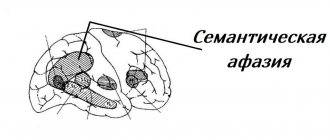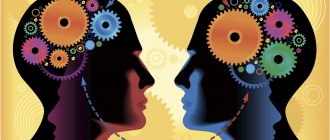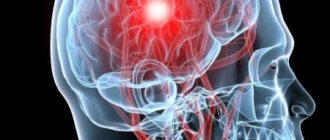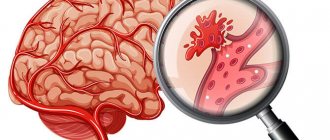Agnosia
(
agnosia
, Greek negative prefix a- and gnosis - cognition, knowledge) - a violation of complex cognitive processes with damage to the gnostic parts of the cerebral cortex.
The phenomena of Agnosia were described by Munk (H. Munk, 1881), who observed that the destruction of certain parts of the occipital region of the brain in animals does not lead to visual impairment, but makes it impossible to recognize objects. The first clinical descriptions of Agnosia were made by Jackson (N. Jackson, 1876), Charcot (JM Charcot, 1882, 1887). Lissauer (N. Lissauer, 1890) described various forms of optical (visual) AGNOsia that arose when the anterior parts of the occipital region of the brain were destroyed.
A significant contribution to the doctrine of AGNOSIS was made by Potzl (O. Potzl, 1926) and his colleagues, who made a number of assumptions about the physiological mechanisms of this phenomenon, by Poppelreuter (W. Poppelreuter, 1917 - 1918), and then by G. Holmes, Zangwill (O. Zangwill), Teuber (N. L. Teuber), who brought together the phenomena of optical AGNOsia with disorders of visual attention. In modern neurology, based on ideas about the mechanisms of analyzers and the modern doctrine of the essence of cognitive activity (gnosis), the doctrine of AGNOSIS and its mechanisms has received sufficient scientific justification.
Agnosia most often occurs with vascular lesions, injuries, and brain tumors.
Agnosia is fundamentally different from the elementary forms of perception disorders that occur with lesions of the eye, visual pathway, or primary (projection) zones of the sensory areas of the cerebral cortex. When the latter are damaged, there is a loss or narrowing of the acuity or volume of elementary sensations of one modality or another (visual - in case of damage to the occipital lobe, auditory - in case of damage to the temporal lobe, cutaneous and kinesthetic - in case of damage to the cortex of the postcentral gyrus of the brain). In contrast, with AGNOsia, elementary forms of sensitivity remain intact, but complex forms of analytical-synthetic activity within a given analyzer are disrupted, and therefore the possibility of transforming elementary sensations in the cerebral cortex into complex (most often reflecting entire objects) forms of perception is difficult or becomes impossible.
Agnosia is always modality-specific. Thus, when the secondary zones of the occipital lobe are damaged, the patient’s perception of complex forms of distinguishing objects, drawings, letters is impaired, but he can clearly distinguish speech sounds, musical sounds, or recreate the image of an entire object by palpation.
On the contrary, with damage to the secondary zones of the temporal lobe (dominant - left hemisphere for right-handed people), the ability to clearly distinguish and recognize speech sounds disappears, but the ability to perceive elementary sounds remains.
Similar phenomena can occur in the tactile sphere with damage to the secondary parts of the cortex of the postcentral gyrus of the brain, as well as in the sphere of smell and taste with damage to the medio-basal parts of the temporal lobe cortex. That is why they distinguish between optical (visual), acoustic (auditory), tactile-kinesthetic AGNOsia, which is also known as astereognosis, olfactory and gustatory agnosia.
Optical or visual agnosia
. Various forms of optical AGNOsia have the greatest clinical significance. (so-called mental blindness). In severe cases, the patient cannot recognize objects and their realistic image (Lissauer's object agnosia), perceiving only their individual signs and guessing about the general meaning of the object or its image. For example, perceiving the image of glasses, the patient says: “a ring, and another ring, and a crossbar - probably a bicycle.”
Similar phenomena of visual agnosia occur with massive (most often bilateral) lesions of the secondary parts of the occipital lobe. In the primary (projection) zones of the cortex of the occipital lobe (Brodmann area 17), the predominant place is occupied by nerve cells located in the IV - internal granular (afferent) layer of the cortex, responding to highly specific signs of visual stimulation: angularity or roundness of lines, movement from the center of the visual field to periphery, etc. This allows the primary areas of the occipital cortex to capture fractional, very specific signs of visual influences.
The strictly somatotopic organization of visual stimuli, captured by the primary (projection) centers of the cerebral cortex and occipital lobe, is also characteristic, as a result of which their partial damage leads to spatially limited loss of individual parts of the visual field (see Hemianopsia, Scotoma). In contrast, among the rosaries of the secondary zones of the occipital lobe cortex (Brodmann's areas 18, 19), the predominant place is occupied by nerve cells with short axons, located in the II - external granular and III - pyramidal layers of the cerebral cortex and serving as an apparatus for isolating individual components of visual stimulation and combining them into entire structures. These cells do not have the high specificity that characterizes the cells of the primary zones of the cortex. Therefore, their irritation leads to a wide spread of excitation to nearby areas of the occipital lobe cortex, resulting not in elementary visual hallucinations (luminous dots, spots, lines), but entire complex visual images. On the contrary, the destruction of these zones of the occipital lobe cortex does not cause spatially limited loss in a separate field, but leads to the inability to synthesize visual images into entire structures and to the impossibility of visual recognition of images of objects and complex geometric shapes.
A test characterizing visual disturbances in agnosia. Signatures under the pictures and words proposed for identification were made by patients: 1 - with an extracerebral tumor of the occipital region; 2 - with softening of the brain in the depths of the left parieto-occipital region.
In less pronounced cases, signs of visual Agnosia appear only in complicated conditions, in particular when perceiving images crossed out or “noisy” with extraneous influences (Fig.).
A special place among visual agnosias is occupied by the characteristic syndrome of the so-called simultaneous AGNOSIA, which manifests itself in the inability to synthetically perceive groups of images that form a whole.
With damage to the secondary sections of the occipital lobe of the dominant (left in right-handed people) hemisphere, the syndrome of visual AGNOsia appears especially clearly when perceiving images of letters or numbers or in changes in the subtlety of perception of objects, leading to a violation of their naming (see Aphasia).
When the secondary centers of the occipital or occipital-parietal region of the subdominant (right) hemisphere of the brain are affected, the AGNOsia syndrome can take on peculiar forms of failure to recognize faces (prosopagnosia) or ignoring the left side of the visual field (unilateral spatial AGNOsia).
Since the time of the classics of neurology (Lissauer and others), it has been customary to distinguish between two main forms of visual Agnosia - apperceptive and associative. In the first case, the patient, who perceives only individual signs of an object or its image, cannot perceive and recognize it as a whole; with the second, the patient clearly perceives objects as a whole and entire images, but does not recognize them and cannot name them. It is this form that comes close to the above-mentioned phenomena of visual AGNOsia.
Spatial agnosia
represents a completely special group of Agnosias, in which the visual perception of individual objects or their images remains intact, but the ability to evaluate spatial relationships is impaired. The patient cannot distinguish between the right and left sides, makes mistakes when analyzing the location of the hands on the clock, when reading and depicting a geographical map. Spatial Agnosia occurs when the tertiary (parieto-occipital) parts of the cerebral cortex are damaged.
Acoustic or auditory agnosia
(“mental deafness”) is characterized by the fact that the patient, who clearly distinguishes sounds and does not show signs of loss of perception of any areas of the tone scale, is unable to distinguish speech sounds (phonemes).
The patient cannot discern the differences between close (so-called oppositional) phonemes that differ in any one feature, for example. deafness and sonority (p - b and t - d), and therefore cannot grasp the meaning of heard words (see Aphasia, sensory) and correctly reproduce and write them. He also loses the ability to recognize objects by the sounds they produce, for example. does not recognize a clock by its ticking, water by its murmur, etc.
Auditory AGNOsia occurs when the secondary centers of the temporal lobe of the dominant (left) hemisphere of the brain are damaged.
Tactile agnosia
is expressed in the fact that the patient, who has retained a fairly subtle tactile sensitivity, is unable to recognize objects by touch. These phenomena are called astereognosis. Some researchers, emphasizing the role of disturbances in the synthesis of individual tactile signs characteristic of these cases, designate this form of A. with the term “amorphosynthesis” [Denny-Brown]. In these cases, as in the case of a violation of spatial gnosis, the phenomena of A. lead to a violation of the gnostic basis of motor processes, and the patient develops disturbances in complex forms of praxis, which are usually designated by the term “apractagnosia.”
Closely related to the described disorders are the phenomena of autotopagnosia, which consists in difficulty determining the location of individual points or areas of the body, recognizing parts of one’s body, and the phenomenon of metamorphopsia, in which the patient begins to perceive parts of his body or foreign objects as unusual, changed in shape or size.
With macropsia, objects seem excessively large to the patient, with micropsia - excessively small. Sometimes the phenomenon of so-called polymelia occurs - a sensation of false limbs that may seem motionless or moving.
Tactile AGNOsia, which concerns the recognition of stimuli coming from the external environment, is observed with damage to the secondary parts of the parietal lobe, mainly the dominant (left) hemisphere. In cases of AGNOsia, which relates to the recognition of one's own body, damage to the right hemisphere is mostly found. A very characteristic fact is that with some lesions of the subdominant (right) hemisphere of the brain, the phenomena of AGNOsia can be accompanied by a peculiar disturbance in the perception of one’s own defects. This phenomenon, called “anosognosia” (or Anton-Babinski syndrome), can be either widespread or more limited in nature and in severe cases leads to the fact that the patient does not notice disturbances in sensitivity and movements (most often on the left side of the body ).
Painful AGNOSIA has also been described, spreading evenly throughout the entire body; the injections are perceived as a touch, but the patient does not feel pain.
Olfactory and gustatory agnosia
. In these forms, the identification of smells and taste sensations is impaired. Dejerine called these forms of agnosia “purely theoretical”, since they are practically indistinguishable from anosmia and ageusia and have no diagnostic value.
A significant issue of great clinical importance is the reversal of the symptoms of AGNOsia or the restoration of cognitive functions impaired as a result of corresponding local brain lesions. This effect can be achieved either in the process of spontaneous compensation, which occurs with relatively minor lesions and with the restoration of hemo- and liquorodynamics, or as a result of special training, in which impaired cognitive processes are restored due to saved analyzers or complex speech (logical) analysis of incoming data. information.
Research methods
Visual Agnosia is examined by presenting the patient with a corresponding object or image with an invitation to recognize it.
As a “sensitized” test for AGNOsia, the patient is presented with stylized shaded or incompletely depicted contour or silhouette figures (Fig.).
When studying tactile AGNOsia, the patient is asked to feel some objects. When studying auditory-speech Agnosia, the patient is asked to repeat speech sounds that are similar in sound - phonemes (for example, b - p, t - d, z - s), or, to avoid difficulties in their pronunciation, point to the corresponding letters, or, finally, develop an appropriate conditioned motor reaction (for example, in response to the sound “b”, raise your right hand, in response to the sound “p” - raise your left hand). When examining olfactory and gustatory A., the patient is presented with a number of different odors and taste stimuli, which he must recognize. Naturally, the resulting defects can be assessed as A. phenomena only in those cases where the acuity of elementary visual, tactile, auditory and other processes remains preserved.
An important issue is the differentiation of genuine Agnosia from those impulsive assessments that arise in similar experiments in patients with damage to the frontal lobes of the brain. The supporting feature in this case is the fact that a patient with damage to the frontal lobes of the brain does not make active attempts to establish the meaning of the proposed object and its assessment is impulsive, while a patient with genuine A. comes to a false assessment of the image, despite numerous active attempts to determine its meaning.
Topical diagnostic value
Agnostic disorders occur especially often with damage to the parietal and parieto-occipital regions of the brain: visual Agnosia - with damage to the posterior parts of the parieto-occipital region (fields 18 and 19 of the occipital lobe, field 39 of the parietal lobe), astereognosis - with damage to the supramarginal field, sometimes postcentral fields, acoustic Agnosia - with damage to the secondary zones of the temporal lobe of the dominant (left) hemisphere.
Agnosia, related to recognition of one's own body, usually occurs when the cortex of the parietal lobe of the brain and its connections with the visual thalamus are damaged. For the most part, damage to the right hemisphere is detected, especially in the presence of anosognosia and polymelia. Olfactory and gustatory AGNOsia develops with damage to the medio-basal areas of the cortex of the temporal lobe of the brain.
Forecast
depends on the nature of the disease and the effectiveness of the therapy.
Bibliography:
Kok E.P. Visual agnosia, L., 1967, bibliogr.; Luria A. R. Higher human cortical functions and their disorders in local brain lesions, M., 1969, bibliogr.; Frederiki J. A. M. The agnosias, Handb. clin. nurol., cd. by PJ Vinken a. G. W. Bruyn, v. 4, p. 13, Amsterdam - NY, 1969, bibliogr.; Lange J. Agnosim und Apraxien, Ilandb. Neurol., hrsg. v. O. Bumke u. O. Focrster, Bd 6, S. 807. B-, 1936, Bibliogr.
AP Lursh.
The concept of optical-spatial functions
INTRODUCTION
Relevance of the topic: With normal ontogenesis, by the age of 6 years, that is, in senior preschool age, children have sufficiently formed optical-spatial functions: visual genesis, visual analysis and synthesis, spatial representations, visual-motor coordination, etc.
However, in older preschoolers, as studies by a number of authors show (N.G. Manelis[9], N.Ya. Semago[14], etc.), not only speech disorders are detected, but also deviations in the development of non-speech mental functions, including number and visuospatial functions. This is due to the systemic nature of mental development, the close relationship in the development of speech and non-speech mental processes.
Speech is a way of forming and formulating thoughts and, at the same time, a means of communication, a social connection of influence on others (L.S. Vygotsky). In this regard, it should be emphasized that speech disorders have a negative impact on the formation of non-speech mental functions, including the development of optical-spatial concepts. The presence of children with secondary deviations in the development of mental processes (including optical-spatial representations) creates additional difficulties in the process of speech formation, in mastering knowledge in general, and in developing readiness for schooling.
The lack of development of optical-spatial functions leads to difficulties in differentiating visual images of letters and numbers, to optical dyslexia and dysgraphia, to dyscalculia, which complicates the school adaptation of children and negatively affects the formation of personality.
Thus, the relevance of the problem of studying optical-spatial representations of older preschoolers is due to a number of reasons of a psychological and pedagogical nature; the formation of visual-spatial functions is a significant prerequisite for mastering literacy.
To optimize the process of teaching and raising children of senior preschool age, it is necessary to purposefully study the psychological characteristics of children, identify and determine the qualitative nature of mental development disorders; in this regard, issues related to identifying the psychological mechanisms of disorders associated with the underdevelopment of optical-spatial functions deserve attention.
Purpose of the study: To identify the features of the formation of optical-spatial functions in children of senior preschool age.
To achieve the goal, a number of tasks have been put forward:
1. Analysis of psychological and pedagogical literature devoted to the formation and development of optical-spatial functions in children of senior preschool age.
2. Selection of methods aimed at studying the level of formation of optical-spatial functions in children of senior preschool age
3. Experimental study of the features of optical-spatial functions in children of senior preschool age.
4. Qualitative and quantitative analysis of the obtained experimental data.
Object of study: optical-spatial functions in children of senior preschool age.
Subject of research: features of the formation of optical-spatial functions in children of senior preschool age.
The theoretical significance of the study is that the understanding of the features of optical-spatial functions in children of senior preschool age has been expanded.
Practical significance of the study This study can be used when planning pedagogical work on the upbringing and training of children of senior preschool age.
CHAPTER 1. THEORETICAL ASPECTS OF DEVELOPMENT OF OPTICAL-SPATIAL FUNCTIONS IN SENIOR PRESCHOOL CHILDREN
The concept of optical-spatial functions
Optical-spatial functions are among the most complex mental processes in structure.
Vision is of great importance in a person’s life. This is the main sensory channel that connects him with the outside world. The human visual system is very complex. Thanks to vision, we perceive the world around us in volume and color; we read and watch movies and TV.
In the human visual system, the following levels of signal processing can be distinguished[1]. At the periphery is the retina. During the development of the nervous system, the retina is formed at the earliest stages of development. Therefore, there is every reason to consider the retina “a part of the brain located in the periphery [2].” The next level of processing of visual information is located in the thalamus - this is the lateral geniculate body. Axons of neurons in the lateral geniculate body project to the cortex of the occipital pole of the cerebral hemispheres. The highest stage of visual signal processing occurs in the association fields of the cerebral cortex.
The human oculomotor system performs the following tasks [2]:
1) keeps the image of the external world on the retina motionless while moving relative to this world;
2) identifies certain objects in the external world, places them in the high-resolution retinal area (optic fovea, fovea) and tracks them with movements of the eyes and head;
3) spasmodic (saccadic) movements of the gaze to scan (examine) the external world. Brief information about the structure of the peripheral part of the oculomotor system was given above. Saccades are rapid, friendly deviations of the eyes in the initial phase of the tracking reaction, when the eye jump “captures” a moving visual target, as well as during visual inspection of the external world.
In one case, both eyes move in the same direction relative to the coordinates of the head, in another case, if a person alternately looks at close and distant objects, each of the eyeballs makes approximately symmetrical movements relative to the coordinates of the head. In this case, the angle between the visual axes of both eyes changes: when fixating a distant point, the visual axes are almost parallel, and when fixing a close point, they converge. These movements are called convergent. When looking at objects at different distances, eye movements are convergent and divergent. If the neural system cannot bring the visual axes of both eyes to the same point in space, strabismus occurs[8].
When viewing various objects in the external world, the eyes make fast (saccades) and slow tracking movements. Thanks to slow tracking movements, the image of moving objects is held on the fovea. When viewing a well-structured image, the eyes make saccades alternating with gaze fixation. If a person looks at an image for some time, then the recording of eye movements reproduces quite roughly the contour and the most informative details of the object in question. For example, when looking at a face, the mouth and eyes are especially often captured.
Special experiments have shown that during a saccade, visual perception is blocked [6]. Several mechanisms for this phenomenon can be proposed. It is assumed that during a saccade over a highly structured background, intensity fluctuations at each point exceed the flicker fusion frequency. Another mechanism that blocks visual perception during a saccade is central inhibition. When a moving object appears in the periphery of the visual field, it causes a reflexive saccade, which may be accompanied by head movement. The basis of the neurophysiological mechanism of this reflex is motion detectors in the visual system. Biologically, the reflex is justified by the fact that thanks to it, attention switches to a new object that appears in the field of vision [10].
Higher gnostic visual functions are provided, first of all, by the work of the secondary fields of the visual system (18th and 19th) and the adjacent tertiary fields of the cerebral cortex. Secondary fields 18 and 19 are located on both the outer convexital and inner medial surfaces of the cerebral hemispheres. They are characterized by a well-developed layer III, in which impulses are switched from one area of the cortex to another.
With electrical stimulation of the 18th and 19th fields, not local, point excitation occurs, as with stimulation of the 17th field, but activation of a wide zone, which indicates broad associative connections of these areas of the cortex.
From studies conducted on humans, it is known that with electrical stimulation of the 18th and 19th fields, complex visual images appear. These are no longer isolated flashes of light, but familiar faces, pictures, and sometimes some vague images. Basic information about the role of these areas of the cerebral cortex in visual functions was obtained from the clinic of local brain lesions.
Clinical observations show that damage to these areas of the cortex and the adjacent subcortical zones (“proximal subcortex”) leads to various disorders of visual gnosis. These disorders are called visual agnosia. This term refers to disorders of visual perception that occur when the cortical structures of the posterior parts of the cerebral hemispheres are damaged and occur with the relative preservation of elementary visual functions (visual acuity, visual fields, color perception). In all forms of agnostic visual disorders, elementary sensory visual functions remain relatively intact, that is, patients see quite well, they have normal color perception, and their visual fields are often preserved; in other words, they seem to have all the prerequisites to perceive objects correctly. However, it is the gnostic level of the visual system that is disrupted in them. In some cases, patients, in addition to gnostic ones, have sensory dysfunctions. But these are, as a rule, relatively subtle defects that cannot explain the severity and nature of disorders of higher visual functions.
The main types of optical-spatial disorders are: unilateral spatial agnosia, disturbance of topographic orientation, as well as some manifestations of Balint's syndrome.
The formation of spatial representations begins already in the early stages of ontogenesis; they are basic for the development of many other mental processes [17].
Assessment of the formation of spatial representations and spatio-temporal representations is carried out in the sequence that these levels do not simply “build on top” of each other in the process of development, but intersect in time, overlapping and “embedded” in each other, experience mutual influences and, in general, closely interconnected way. As in the case of studying the voluntary regulation of mental activity, it is necessary to evaluate the “mature”, sufficiently formed level of spatial representations (in accordance with normative or typological concepts) and the closest “deficient” (unformed completely or partially) level or, accordingly, sublevel[8 ].











